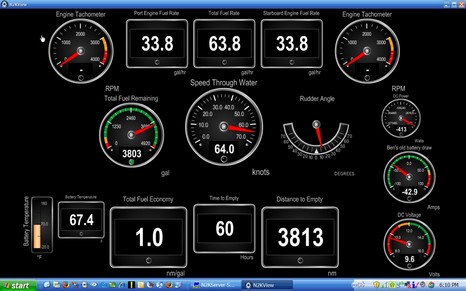Fuel management 4, Maretron N2KView

Remember Maretron’s N2KView? I tried the initial version last fall, and later wrote a column about the whole concept of packetizing NMEA 2000 data. Recently I’ve been testing Version 2.0 and can tell you that it’s faster, prettier, and more configurable—better in every way. Perhaps more important, though, is Maretron’s recent decision to position the original $2,995 product—which can or will eventually control switches, take action on alarms, handle cameras, etc.—as the Platinum version, and offer a Standard view-the-data-anywhere version for $995 (as explained in this PDF).
The only data exceptions, unfortunate for this particular entry, are the fuel management calculations. I’ll guess that was a marketing decision, but I am learning that in N2K world, calculated values have a different, and often more confusing, role than straight sensor data. At any rate, you’ve got to pay the big bucks to get that neat screen above, which I built in about half an hour, but it’s worth checking out bigger if only to get a sense of how N2KView gauges have evolved.
Note that most everything you see—range, alarm colors, labels—is easily customized. The live fuel data is coming from the twin FloScan simulators (note the “Garmin right, Panbo wrong” PS added to that entry!) and a single Maretron tank level sender, as you can further see in the Distance to Empty (aka Range) gauge set-up screen below. It would be nice if those “instances” could have aliases like “Main Fuel Tank” but either I haven’t figured out how to do that or it isn’t possible yet. Note too that Maretron is figuring Range on tank level whereas the other guys already doing thorough N2K fuel management display—Garmin, Lowrance, FloScan, and Yanmar (that I know of)—prefer to calculate range on a flow-based fuel remaining figure (as discussed in the Yanmar entry). But then again, all those other companies offer their own fuel flow sensing of one sort or another, while Maretron is trying hard to make the most of all standard N2K PGNs…and come up with new sensors too. In that regard, note the various DC power gauges on that screen shot. The actual numbers are bogus, because I haven’t yet properly set up Maretron’s new DC Monitor (and yesterday’s press release PDF here). But I sure will, and am excited that battery health, device amperage draws, etc. will become yet more valuable data circulating on N2K backbones. (Though, like fuel flow, it will probably be while before many displays learn how to use it well.)
PS 7/28: Oops, it’s been pointed out that the total fuel rate in the screen above is not the total of the individual engine rates. It’s completely my fault; the total is true but the port engine rate is showing for both engines. At the time, it was actually 30.1. Here’s a “night screen” showing all correct rates
.













